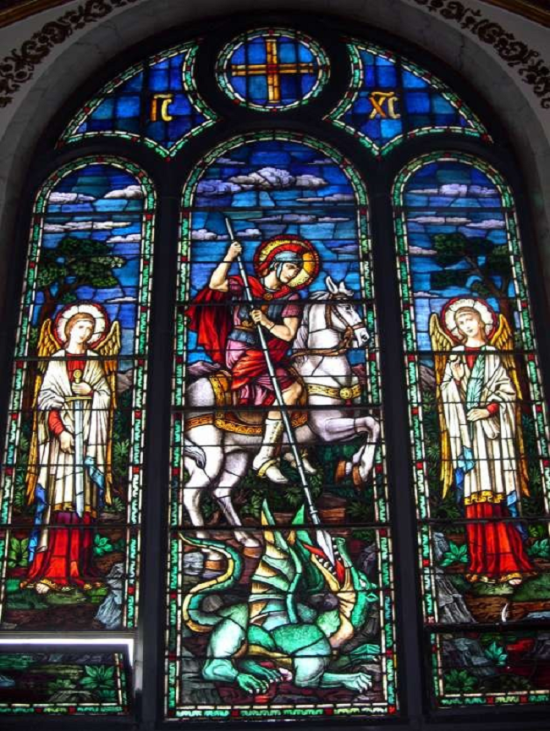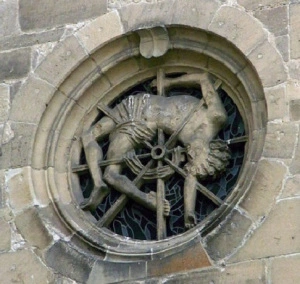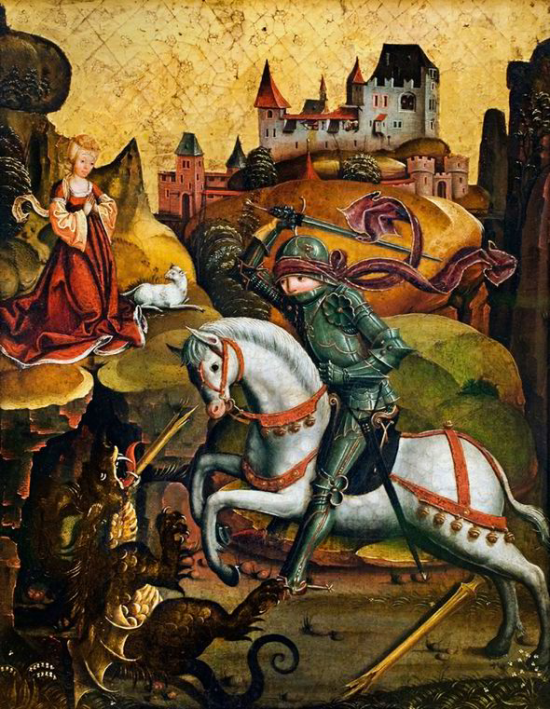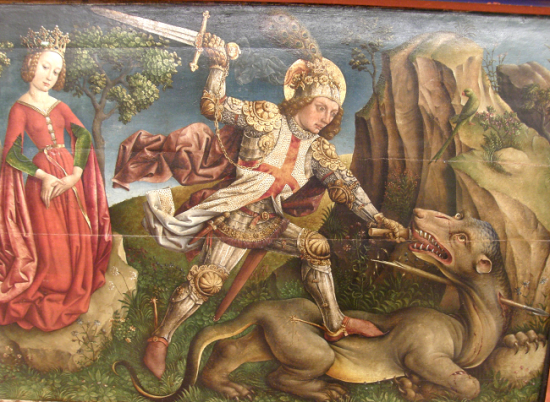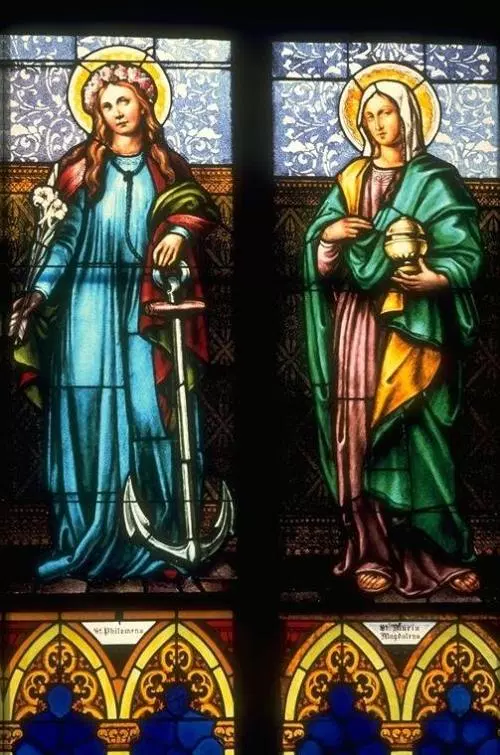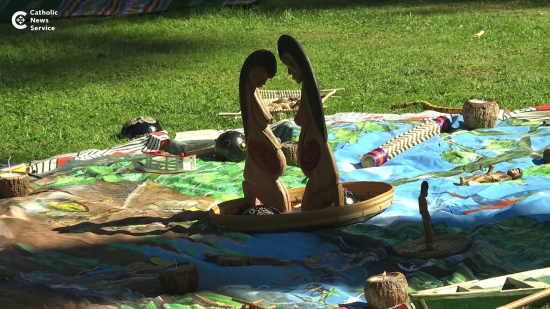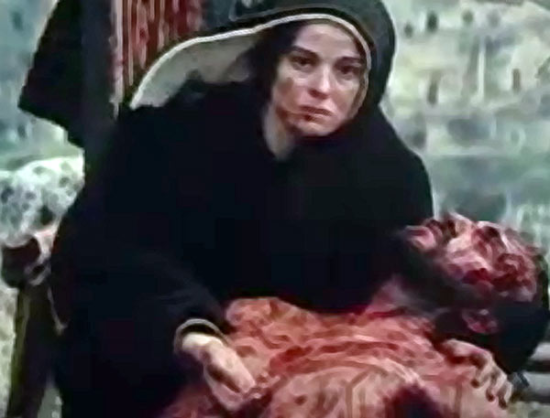
This was posted five years ago [now seven years in 2024]. A good day to bring this to light once again. Outside of Saint Philomena – the veracity of whose existence as a virgin and martyr of the early Church has recently been sustained by exhaustive scientific evaluations of the evidence – outside of her… there is perhaps no saint more scorned as being no more than a figment of pious imagination than Saint George, who, however, boasts of more archaeological and historical evidence than most any other saint in the history not only of the early Church, but for some lesser known saints, right into our own day. Churches dedicated to Saint George sprang up in their dozens throughout the ancient world immediately after news of his martyrdom on 23 April 303.
Liberal warning: The most obnoxious denial of the existence of Saint George that I’ve come across comes from a super liberal professor of “ecumenism” (which I put in quotes because he had no idea what true ecumenism is). Many of my fellow priests today have had Father XXX as a professor in the various countries, seminaries and universities where he’s misled people. He had the idea that Saint George couldn’t possibly have existed because of the iconography of him slaying a dragon. This priest-professor’s arrogant idea was that we’re very smart today, and people of the past were so very gullible and stupid. He laughed his nervous, cowardly, mocking laugh when I tried to explain a few things about the iconography:
- Those in the first centuries, who were suffering under the severe persecutions of the dragon of the Apocalypse, namely, the possessed-by-Satan pre-Constantinian Roman Empire, understood the dragon to be the Roman Empire. Even so, such depictions only came later, but for this very reason.
- The white horse, similarly, is the white horse of the Apocalypse 6:2, whose rider goes out conquering and to further his conquering.
- In the early fourth century, after George was martyred, it is interesting to note that all martyrs in the Montefiascone/Bolsano region of Tuscany, whether male or female, with no regard to how they met their deaths, were all depicted as riding on the white horse of the Apocalypse.
- The woman who is to be saved in the background of some Renaissance paintings is, similarly, Holy Mother Church, who is represented by her saints.
- The point of all this wonderful triumphalism in the iconography is not that Saint George or the other martyrs successfully fought their way out of being martyred. The point is not that they slew the dragon by, for instance, assassinating the Emperor of the time. It’s that they conquered the demonically controlled world by witnessing to Christ Jesus’ goodness and kindness and truth right unto their deaths, so hated is goodness and kindness and truth by the demonically controlled world. Saint George and the other martyrs slew the dragon by continuing in faithfulness while being slain.
- By the way, the dragon, the ancient serpent, the devil and Satan, of Genesis 2:4-3:24, is, in the ancient usage of the word, an Oracle from God on behalf of man, a spirit, an angel, now a fallen angel. There are no talking snakes in Genesis. We’re talking about Satan here. The ancients knew this. Why is it that we don’t in all our clever self-congratulation?
None of this – or the archaeological proofs – made any impression on the super-liberal priest to whom I was speaking, for the last thing he wanted to hear was faithfulness to the Church unto death. That’s not what his own life was about. He was against all doctrine, all morality, all Sacred Revelation. Since he couldn’t answer in any reasonable way, he merely laughed his nervous, cowardly, mocking laugh once again. I was to see the “spirit” of that priest in so many other priests throughout my whole priesthood. Such adversity is an occasion by which friendship with Christ Jesus and the Saints can flourish.

This icon was given to me by Cardinal […]. It’s from the Mount Zion crowd just outside the wall of the Old City of Jerusalem. There is great devotion to Saint George in Palestine until today, with about every third boy being named after Saint George.
George’s father, Gerontius, was well known to the Emperor Diocletian as one of his very best soldiers. When Gerontius’ son George applied to Diocletian to be in the military service of the Emperor, Diocletian quickly made him part of the Imperial Guard and gave him the rank of Tribune. These positions taken together made young George, perhaps in his early twenties, almost as powerful as the Emperor himself. Very few people would have ever had such power, both military and political, and at such a young age. George was an instant phenomenon. Everyone would have known exactly who he was in the entire ancient world.
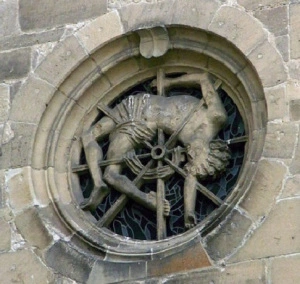
Diocletian was persuaded by the might-makes-right Galerius to have all his soldiers offer sacrifice to the Roman gods. George, with the zeal of the saints, loudly and with great reason proclaimed his worship of Christ Jesus, so that he couldn’t possibly offer sacrifice to any Roman gods. Diocletian, distraught – for he had never intended this – offered George all sorts of bribes, all of which were scorned by our Saint. Diocletian then set out to make an example of him, first attaching him to a wheel of swords and then having him decapitated.
Saint George and Saint Michael the Archangel sometimes meld into one presentation with wings being granted to Saint George on his white horse. That’s O.K. I’m sure they were great friends!
By the way, George is the Name of God the Father: ὁ πατήρ μου ὁ γεωργός ἐστιν (John 15:1). “My Father is George.” O.K., so, a pedantic translation would be “My Father is the Farmer” or “My Father is the Tiller of the Ground.” Some translations have “Vinedresser.” Truth be told, it’s γεωργός, that is, George!
Just to be insistent about this: “Adam” means “Tiller of the Ground.” “Adam” = “George.” Jesus is the New Adam. Jesus is the New George. Yours truly is merely the old George, the old Adam. But Christ has conquered and goes out to conquer still. Thanks be to God our Father that Jesus sets about slaying me so that, dead to myself, I live for Him alone. Yikes!

By the way, my parish, which takes in the most outrageously beautiful mountains of the Great Smoky Mountains, boasts, of course, of being at one end of “The Dragon’s Tail”, which is an extremely dangerous curvy road that every motorcycle enthusiast in North America loves to ride. They all come here! There are hotels just for two-wheelers throughout the area. There are all sort of motorcycle fix-it shops. I invite all cyclers to to make a weekend of this, slaying the dragon by the tail, and stopping in for Mass at 8:30 Sunday morning at Prince of Peace Catholic Church in Robbinsville, NC, or 11:00 Mass Sunday morning at Holy Redeemer Catholic Church in Andrews, N.C. If you’re not afraid of heights or gravel roads, come to Andrews from Robbinsville over Tatham Gap Road. If you’ve never once said “Yikes!” in your life, you will when you ride this one. I say that in solidarity, as most all my broken bones in life (really very many) have come from riding on two wheels with a motor.


